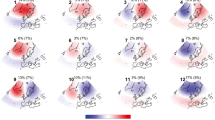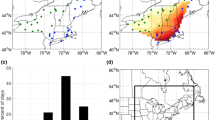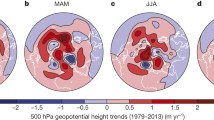Abstract
Various methods of cluster analysis are used for identifying large-scale atmospheric circulation regimes (weather regimes (WRs)). In this paper we compare the four most commonly used clustering methods: k-means (KM), Ward’s hierarchical clustering (HW), Gaussian mixture model (GM), and self-organizing maps (SOMs) to analyze WRs in the Euro-Atlantic (EAT) region. The data used for identifying WRs are 500 hPa geopotential height fields (z500) from the ERA5 reanalysis for 1940–2022. Four classical wintertime WRs are identified by the KM method—two regimes associated with positive and negative phases of the North Atlantic Oscillation (NAO+ and NAO–), a regime associated with the Scandinavian blocking (SB), and a regime characterized by elevated pressure over the Northern Atlantic. For summer months, the KM method gets WRs that are similar in spatial structure to the classical winter ones. The SOM method yields results that are almost identical to the results of the KM method. Unlike KM and SOM methods, HW and GM do not fully catch the spatial structure of all of the four classical winter EAT WRs and their summer analogues. Compared to WRs of the KM and SOM methods, WRs obtained by HW and GM methods explain less z500 variance; they have different occurrences, persistence, and transition features. Summer and winter WRs obtained by HW and GM methods are less similar to each other compared to WRs provided by the KM method. Average spatial correlation coefficients between mean z500 fields of WRs obtained by KM and HW methods are 0.76 in winter and 0.83 in summer; 0.70 in winter and 0.72 in summer for KM and GM methods; and 0.41 in winter and 0.44 in summer for the regimes compared between HW and GM methods, respectively. There are statistically significant trends of the seasonal occurrence of WRs found by some of the studied clustering methods—a positive trend for the occurrence of the NAO+ regime and a negative trend for the occurrence of the NAO-regime.





Similar content being viewed by others
REFERENCES
Arthur, D. and Vassilvitskii, S., K-means++ the advantages of careful seeding, in Proceedings of the Eighteenth Annual ACM-SIAM Symposium on Discrete Algorithms, 2007, pp. 1027–1035.
Babanov, B.A., Semenov, V.A., Akperov, M.G., Mokhov, I.I., and Keenlyside, N.S., Occurrence of winter atmospheric circulation regimes in Euro–Atlantic region and associated extreme weather anomalies in the Northern Hemisphere, Atmos. Oceanic Opt., 2023, vol. 36, no. 5, pp. 522–531.
Banfield, J.D. and Raftery, A.E., Model-based Gaussian and non-Gaussian clustering, Biometrics, 1993, pp. 803–821.
Bao, M. and Wallace, J.M., Cluster analysis of Northern Hemisphere wintertime 500-hPa flow regimes during 1920–2014, J. Atmos. Sci., 2015, vol. 72, no. 9, pp. 3597–3608.
Bardin, M.Yu. and Platova, T.V., Long-period variations in extreme temperature statistics in Russia as linked to the changes in large-scale atmospheric circulation and global warming, Russ. Meteorol. Hydrol., 2019, no. 12, pp. 791–801.
Barnston, A.G. and Livezey, R.E., Classification, seasonality and persistence of low-frequency atmospheric circulation patterns, Mon. Weather Rev., 1987, vol. 115, no. 6, pp. 1083–1126.
Baur, F., Hess, P., and Nagel, H., Kalender der Großwetterlagen Europas 1881–1939, Bad Homburg, 1944.
Bilmes, J.A., A gentle tutorial of the EM algorithm and its application to parameter estimation for Gaussian mixture and hidden Markov models, Int. Comput. Sci. Inst., 1998, vol. 4, no. 510, p. 126.
Bradley, P.S. and Fayyad, U.M., Refining initial points for k-means clustering, in Proceedings of the Fifteenth International Conference on Machine Learning (ICML-98), San Francisco, Calif.: Morgan Kaufmann, 1998, pp. 91–99.
Cassou, C., Intraseasonal interaction between the Madden–Julian oscillation and the North Atlantic Oscillation, Nature, 2008, vol. 455, no. 7212, pp. 523–527.
Cattiaux, J., Vautard, R., Cassou, C., Yiou, P., Masson-Delmotte, V., and Codron, F., Winter 2010 in Europe: A cold extreme in a warming climate, Geophys. Res. Lett., 2010, vol. 37, no. 20.
Charlton-Perez, A.J., Ferranti, L., and Lee, R.W., The influence of the stratospheric state on North Atlantic weather regimes, Q. J. R. Meteorol. Soc., 2018, vol. 144, no. 713, pp. 1140–1151.
Cheng, X. and Wallace, J.M., Cluster analysis of the Northern Hemisphere wintertime 500-hPa height field: Spatial patterns, J. Atmos. Sci., 1993, vol. 50, no. 16, pp. 2674–2696.
Christiansen, B., Atmospheric circulation regimes: Can cluster analysis provide the number?, J. Clim., 2007, vol. 20, no. 10, pp. 2229–2250.
Corti, S., Molteni, F., and Palmer, T.N., Signature of recent climate change in frequencies of natural atmospheric circulation regimes, Nature, 1999, vol. 398, no. 6730, pp. 799–802.
Dawson, A., Palmer, T.N., and Corti, S., Simulating regime structures in weather and climate prediction models, Geophys. Res. Lett., 2012, vol. 39, no. 21.
Dzerdzeevskii, B.L., Kurganskaya, V.M., and Vitvitskaya, Z.M., Tipizatsiya tsirkulyatsionnykh mekhanizmov v severnom polusharii i kharakteristika sinopticheskikh sezonov, Trudy NIU GUGMS (Typification of Circulation Mechanisms in the Northern Hemisphere and Characteristics of Synoptic Seasons, Transactions of the Scientific Research Office of the Main Directorate of Hydrometeorological Service), Leningrad: Gidrometizdat. 1946.
Fabiano, F., Christensen, H.M., Strommen, K., Athanasiadis, P., Baker, A., Schiemann, R., and Corti, S., Euro–Atlantic weather regimes in the primavera coupled climate simulations: Impact of resolution and mean state biases on model performance, Clim. Dyn., 2020, vol. 54, pp. 5031–5048.
Falkena, S.K., de Wiljes, J., Weisheimer, A., and Shepherd, T.G., Revisiting the identification of wintertime atmospheric circulation regimes in the Euro–Atlantic sector, Q. J. R. Meteorol. Soc., 2020, vol. 146, no. 731, pp. 2801–2814.
Folland, C.K., Knight, J., Linderholm, H.W., Fereday, D., Ineson, S., and Hurrell, J.W., The summer North Atlantic Oscillation: Past, present, and future, J. Clim., 2009, vol. 22, no. 5, pp. 1082–1103.
Girs, A.A., Makrotsirkulyatsionnyi metod dolgosrochnykh meteorologicheskikh Prognozov (Macrocirculation Method for Long-Term Meteorological Forecasts), Leningrad: Gidrometeoizdat, 1974.
Govender, P. and Sivakumar, V., Application of k-means and hierarchical clustering techniques for analysis of air pollution: A review (1980–2019), Atmos. Pollut. Res., 2020, vol. 11, no. 1, pp. 40–56.
Greene, C.A., Thirumalai, K, Kearney, K.A., et al., The climate data toolbox for Matlab, Geochem., Geophys., Geosyst., 2019, vol. 20, no. 7, pp. 3774–3781.
Guemas, V., Salas-Mélia, D., Kageyama, M., Giordani, H., Voldoire, A., and Sanchez-Gomez, E., Summer interactions between weather regimes and surface ocean in the North-Atlantic region, Clim. Dyn., 2010, vol. 34, pp. 527–546.
Hannachi, A., Low-frequency variability in a GCM: Three-dimensional flow regimes and their dynamics, J. Clim., 1997, vol. 10, no. 6, pp. 1357–1379.
Hartigan, J.A. and Wong, M.A., A k-means clustering algorithm, Appl. Stat., 1979, vol. 28, no. 1, pp. 100–108.
Hersbach, H., Bell, B., Berrisford, P., et al., The ERA5 global reanalysis, Q. J. R. Meteorol. Soc., 2020, vol. 146, no. 730, pp. 1999–2049.
Hess, P. and Brezowsky, H., Katalog der Großwetterlagen Europas 1881–1976, 3. Verbesserte und Ergänzte Auflage, Ber. Dtsch. Wetterdienstes, 1977, vol. 113, pp. 1–140.
Hurrell, J.W., Decadal trends in the North Atlantic Oscillation: Regional temperatures and precipitation, Science, 1995, vol. 269, no. 5224, pp. 676–679.
Hurrell, J.W., Kushnir, Y., Ottersen, G., and Visbeck, M., An overview of the North Atlantic Oscillation, in The North Atlantic Oscillation: Climatic Significance and Environmental Impact, Washington, DC: American Geophysical Union, 2003, vol. 134, pp. 1–36.
Huth, R., Beck, C., Philipp, A. et al., Classifications of atmospheric circulation patterns: Recent advances and applications, Ann. New York Acad. Sci., 2008, vol. 1146, no. 1, pp. 105–152.
James, P.M., An objective classification method for Hess and Brezowsky Grosswetterlagen over Europe, Theor. Appl. Climatol., 2007, vol. 88, pp. 17–42.
Kanungo, T., Mount, D.M., Netanyahu, N.S., Piatko, C.D., Silverman, R., and Wu, A.Y., An efficient k-means clustering algorithm: Analysis and implementation, IEEE Trans. Pattern Anal. Mach. Intell., 2002, vol. 24, no. 7, pp. 881–892.
Kearns, M., Mansour, Y., and Ng, A.Y., An information–theoretic analysis of hard and soft assignment methods for clustering, in Learning in Graphical Models, Dordrecht: Springer, 1998, pp. 495–520.
Khan, K., Rehman, S.U., Aziz, K., Fong, S., and Sarasvady, S., DBSCAN: Past, present and future, in The Fifth International Conference on the Applications of Digital Information and Web Technologies (ICADIWT-2014), IEEE, 2014, pp. 232–238.
Kohonen, T., Self-Organizing Maps, Berlin: Springer, 2012.
Kondrashov, D., Ide, K., and Ghil, M., Weather regimes and preferred transition paths in a three-level quasigeostrophic model, J. Atmos. Sci., 2004, vol. 61, no. 5, pp. 568–587.
Lamb, H.H., British Isles Weather Types and a Register of the Daily Sequence of Circulation Patterns 1861–1971, Geophysical Memoirs No. 116, London: Her Majesty’s Stationery Office, 1972.
Lamrous, S. and Taileb, M., Divisive hierarchical k-means, in 2006 International Conference on Computational Intelligence for Modelling Control and Automation and International Conference on Intelligent Agents Web Technologies and International Commerce (CIMCA'06), IEEE, 2006, pp. 18–18.
Liu, Y. and Weisberg, R.H., A review of self-organizing map applications in meteorology and oceanography, in Self-Organizing Maps: Applications and Novel Algorithm Design, InTechOpen, 2011, vol. 1, pp. 253–272.
Loikith, P.C., Lintner, B.R., and Sweeney, A., Characterizing large-scale meteorological patterns and associated temperature and precipitation extremes over the northwestern United States using self-organizing maps, J. Clim., 2017, vol. 30, no. 8, pp. 2829–2847.
Lund, I.A., Map-pattern classification by statistical methods, J. Appl. Meteorol. Climatol., 1963, vol. 2, no. 1, pp. 56–65.
Matsueda, M. and Palmer, T.N., Estimates of flow-dependent predictability of wintertime Euro–Atlantic weather regimes in medium-range forecasts, Q. J. R. Meteorol. Soc., 2018, vol. 144, no. 713, pp. 1012–1027.
Michelangeli, P.A., Vautard, R., and Legras, B., Weather regimes: Recurrence and quasi stationarity, J. Atmos. Sci., 1995, vol. 52, no. 8, pp. 1237–1256.
Molteni, F., Tibaldi, S., and Palmer, T.N., Regimes in the wintertime circulation over northern extratropics. I: Observational evidence, Q. J. R. Meteorol. Soc., 1990, vol. 116, no. 491, pp. 31–67.
Murtagh, F. and Contreras, P., Algorithms for hierarchical clustering: An overview, Wiley Interdiscip. Rev.: Data Mining Knowl. Discovery, 2012, vol. 2, no. 1, pp. 86–97.
Murtagh, F. and Contreras, P., Algorithms for hierarchical clustering: an overview, ii, Wiley Interdiscip. Rev.: Data Mining Knowl. Discovery, 2017, vol. 7, no. 6, p. e1219.
Philipp, A., Della-Marta, P.M., Jacobeit, J., Fereday, D.R., Jones, P.D., Moberg, A., and Wanner, H., Long-term variability of daily North Atlantic–European pressure patterns since 1850 classified by simulated annealing clustering, J. Clim., 2007, vol. 20, no. 16, pp. 4065–4095.
Polo, I., Ullmann, A., Roucou, P., and Fontaine, B., Weather regimes in the Euro–Atlantic and Mediterranean sector, and relationship with West African rainfall over the 1989–2008 period from a self-organizing maps approach, J. Clim., 2011, vol. 24, no. 13, pp. 3423–3432.
Roux, M., A comparative study of divisive and agglomerative hierarchical clustering algorithms, J. Classif., 2018, vol. 35, pp. 345–366.
Santos, J.A., Corte-Real, J., and Leite, S.M., Weather regimes and their connection to the winter rainfall in Portugal, Int. J. Climatol.: J. R. Meteorol. Soc., 2005, vol. 25, no. 1, pp. 33–50.
Selesnick, I.W. and Burrus, C.S., Generalized digital Butterworth filter design, IEEE Trans. Signal Process., 1998, vol. 46, no. 6, pp. 1688–1694.
Selim, S.Z. and Alsultan, K., A simulated annealing algorithm for the clustering problem, Pattern Recognit., 1991, vol. 24, no. 10, pp. 1003–1008.
Shi, C., Wei, B., Wei, S., et al., A quantitative discriminant method of elbow point for the optimal number of clusters in clustering algorithm, EURASIP J. Wireless Commun. Networking, 2021, vol. 2021, no. 1, pp. 1–16.
Smyth, P., Ide, K., and Ghil, M., Multiple regimes in Northern Hemisphere height fields via mixture-model clustering, J. Atmos. Sci., 1999, vol. 56, no. 21, pp. 3704–3723.
Vautard, R., Multiple weather regimes over the North Atlantic: Analysis of precursors and successors, Mon. Weather Rev., 1990, vol. 118, no. 10, pp. 2056–2081.
Vautard, R., Mo, K.C., and Ghil, M., Statistical significance test for transition matrices of atmospheric Markov chains, J. Atmos. Sci., 1990, vol. 47, no. 15, pp. 1926–1931.
Vorobyeva, V. and Volodin, E., Evaluation of the INM RAS climate model skill in climate indices and stratospheric anomalies on seasonal timescale, Tellus, Ser. A, 2021, vol. 73, no. 1, p. 1892435.
Willmott, C.J., Synoptic weather-map classification: Correlation versus sums-of-squares, Prof. Geographer, 1987, vol. 39, no. 2, pp. 205–207.
Yang, M.S., Lai, C.Y., and Lin, C.Y., A robust EM clustering algorithm for Gaussian mixture models, Pattern Recognit., 2012, vol. 45, no. 11, pp. 3950–3961.
ACKNOWLEDGMENTS
We thank M.V. Bardin for valuable comments and constructive suggestions.
Funding
A comparison of methods for identifying WRs was carried out with the support from the Ministry of Education and Science of the Russian Federation, agreement no. 075-15-2021-577; data preprocessing and analysis of changes in the characteristics of the regimes were carried out with support from grants from the Russian Science Foundation 19-17-00242 and RCNI 20-55-14003 ANF_a.
Author information
Authors and Affiliations
Corresponding author
Ethics declarations
The authors of this work declare that they have no conflicts of interest.
Additional information
Publisher’s Note.
Pleiades Publishing remains neutral with regard to jurisdictional claims in published maps and institutional affiliations.
Rights and permissions
About this article
Cite this article
Babanov, B.A., Semenov, V.A. & Mokhov, I.I. Comparison of Cluster Analysis Methods for Identifying Weather Regimes in the Euro-Atlantic Region for Winter and Summer Seasons. Izv. Atmos. Ocean. Phys. 59, 605–623 (2023). https://doi.org/10.1134/S0001433823060026
Received:
Revised:
Accepted:
Published:
Issue Date:
DOI: https://doi.org/10.1134/S0001433823060026




